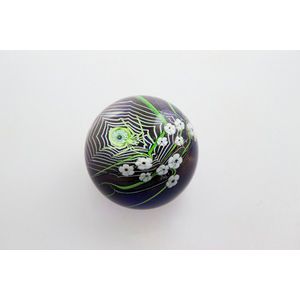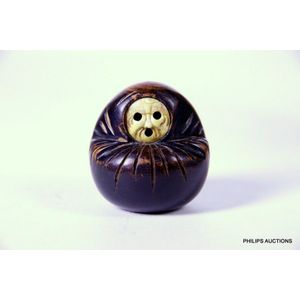Kobe Daruma Doll with Retractable Eyes and Tongue
A novelty Japanese Kobe Ningyo Daruma doll, Meiji to Taisho period, late 19th to early 20th century, Made as tourist toys in the port, of Kobe, the small, carved wooden toy with an ivory or celluloid mask face with amusing, retractable eyes and tongue, height 4.5 cm
You must be a subscriber, and be logged in to view price and dealer details.
Subscribe Now to view actual auction price for this item
When you subscribe, you have the option of setting the currency in which to display prices to $Au, $US, $NZ or Stg.
This item has been sold, and the description, image and price are for reference purposes only.
- Ivory - Ivory is a hard white material that comes from the tusks of elephants, mammoth, walrus and boar, or from the teeth of hippopotamus and whales. The ivory from the African elephant is the most prized source of ivory. Although the mammoth is extinct, tusks are still being unearthed in Russia and offered for sale.
Ivory has been used since the earliest times as a material for sculpture of small items, both in Europe and the east, principally China and Japan.
In Asia ivory has been carved for netsuke, seals, okimono, card cases, fan supports, animals and other figures and even as carved tusks.
In the last 200 years in Europe ivory has been used to carve figures, for elaborate tankards, snuff boxes, cane handles, embroidery and sewing accessories, in jewellery and as inlay on furniture. Its more practical uses include being used for billiard balls, buttons, and a veneers on the top of piano keys.
The use and trade of elephant ivory have become controversial because they have contributed to Due to the decline in elephant populations because of the trade in ivory, the Asian elephant was placed on Appendix One of the Convention on International Trade in Endangered Species (CITES), in 1975, and in January 1990, the African elephant was similarly listed. Under Appendix One, international trade in Asian or African elephant ivory between member countries is forbidden. Unlike trade in elephant tusks, trade in mammoth tusks is legal.
Since the invention of plastics, there have been many attempts to create an artificial ivory - Celluloid - In 1864 an American scientist by the name of Parkes mixed camphor with nitrocellulose, etc. The result was what came to be known as "celluloid", the first form of plastic, and a product for which Parkes could find no use.
Some time later when the supplies of ivory for making billiard balls were becoming difficult to obtain, an inventor produced a perfect billiard ball from a mould using "celluloid".
Toys, dolls and other products such as combs, cutlery handles and costume jewellery made from celluloid began appearing on the market from 1913 and continued to do so until the early 1950s by which time it was superseded by more modern products due to safety concerns because it was highly flammable and brittle product.
This item has been included into following indexes:
Visually similar items

Regal Mashman rose bowl. Blue pink drip glaze, of spherical form. Height 14 cm
Sold by
in
for
You can display prices in $Au, $US, $NZ or Stg.

A Garry Nash 'Blue Reef' vase, ovoid shape, mottled blue over red colour-way, signed and dated '15. Height 22.5 cm.
Sold by
in
for
You can display prices in $Au, $US, $NZ or Stg.

Paperweight, Orient & Flume spider on web with flowers, dated 1980
Sold by
in
for
You can display prices in $Au, $US, $NZ or Stg.

Gary Nash, iridescent vase, unsigned, 14 cm height
Sold by
in
for
You can display prices in $Au, $US, $NZ or Stg.
